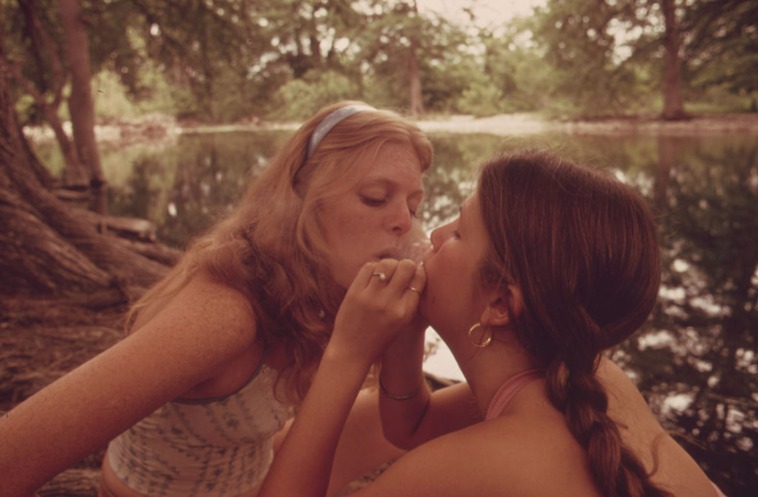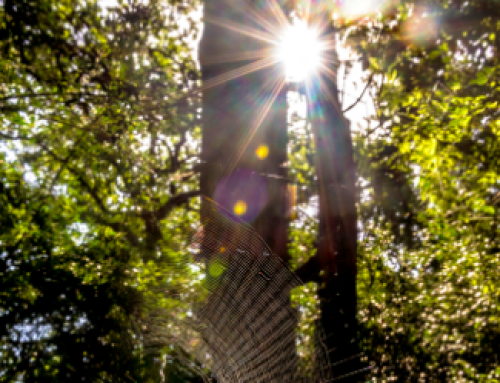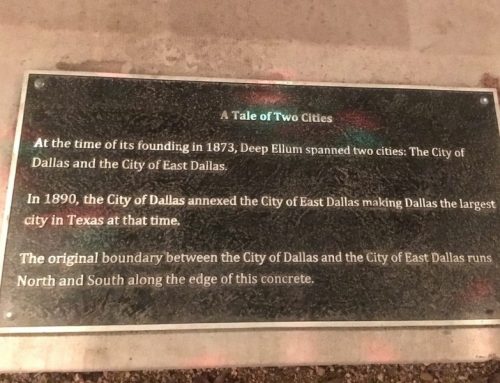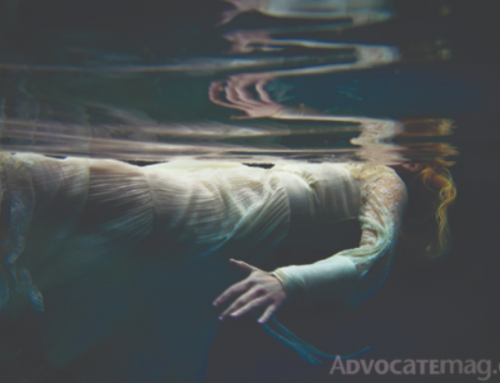
Screenshot of Dallas Municipal Archives video
That was at about 3:25 p.m., and reinforcements were descending. They pulled up in squad cars and some carried shotguns, held high.
“Police said officers arriving to aid the patrolman were greeted with a barrage of rocks, beer bottles and any other handy objects,” according to a March 6, 1977 DMN article reported by Tom Belden and Bill Kenyon.
“By 4 p.m. tactical officers from every part of the city had been called in.”
Before it was over, at least one officer had fired his shotgun into the air (the video has no sound, but shows a puff of gunpowder and the backfire of the weapon); occupants of two Dallas Police helicopters ordered people to disperse as they hovered above the crowd and even landed on the Bath House lawn for about 10 seconds; officers swept the crowd, swinging billyclubs and flashlights as they advanced, injuring many, according to the DMN. Much of the carnage is caught on the video. In a particularly violent incident, an officer drags a thin young man whose arms are secured behind his head as a second officer strikes the detainee’s exposed gut with a club or flashlight.
After the riot, White Rock Lake felt wrong, almost forbidding
The day culminated in 49 arrests, countless injuries (to both hippie and cop) and at least three hospitalizations, including that of Sgt. Kenneth Heard, who arrived on the scene as the fracas gained steam and “shot his service revolver into the air in an attempt to break up the crowd,” according to the DMN story. “Dozens of young persons were grabbed by police, wrestled to the ground, handcuffed and lined up in the grass, face down.”

Screenshot of Dallas Municipal Archives video
Heard spent that night under observation at Doctors Hospital. All of the injured arrestees were taken to Parkland Memorial. Most were charged with disturbing the peace. Two, Gordon Ricketts, 23, and Roy Fontenot, 20, each received an aggravated assault charge — Ricketts reportedly kicked a policeman in the groin as his buddy struck the officer in the head with a beer bottle. An 18-year- old was identified and charged the following day for striking an officer with his car during the riot (no word on that officer’s injuries).
From his hospital bed, Heard justified the shots he and his men fired into the air during the standoff. “We were surrounded and about to be overrun by a mob. It was the only thing we could have done.”
Based on the reports and video, the crowd had thinned by 5 p.m.
Still, dozens of people remained at the park afterward, we see in the video, and a few go on casually tossing a Frisbee.
David West, who was 14, regularly rode his bike around the lake, always stopping to watch the “hippie” multitudes gathered near the Bath House to toss the football, drink beer and brandish cool cars.
“I was not there that day,” West notes in the Texas Archive forum. “But I was witness to the sudden change afterward. It was really kind of creepy, especially to a kid just starting to experience his freedom, then suddenly seeing that freedom snuffed out so completely. After the riot, White Rock Lake felt wrong, almost forbidding.”
Dane Myers, 19 at the time, says he was “proud of the crowd’s moxie and balls, standing up against police brutality.”
He and most of his friends distanced from the fray, “but we watched it unfold like watching a movie — from the first cop punching the first hippie. I was a hippie at 19 years old in 1977. I will always be proud of my generation’s understanding of the freedom fought for and given to us from the previous generation.”
Homeowners in the area offered a far less quixotic take on the situation. They had been complaining for months to police and city council members about crowds leaving trash, relieving themselves in private yards, speeding, cursing, blasting music and parking without regard.
I will always be proud of my generation’s understanding of the freedom fought for and given to us from the previous generation
“I believe in people having a good time and everything else, but when they get on the street speeding and park cars on lawns and leave them, it becomes a difficult situation,” A.D. McManus, a resident near the Bath House, told the Dallas Morning News a few days after the ruckus. “You tell them to slow down and they just give you the finger or yell an obscenity.”
Another lakeside dweller described a young woman abandoning a car for hours in an inconvenient, illegal spot.
“My husband told her she was blocking the driveway, and she just made a gesture. And it certainly wasn’t a ladylike gesture.”
These neighbors told DMN that their grievances to police and Dallas City Hall had “fallen on deaf ears.”
A Letter to the Editor on March 11 complained that councilmen William Cothrum and Richard Smith “wanted to treat the weekend affair as an isolated incident,” and they did not immediately propose new rules.
Barry Secrest, 8 years old at the time, watched the whole thing from his family home on Lake Highlands Drive. He notes that after that day, his “parents and many others petitioned the City of Dallas to put the barricades up on Lawther Drive.”
That was the beginning of the end of the weekly car parade around White Rock Lake.
“They are still up to this day, preventing further cruising,” Secrest says.
My husband told her she was blocking the driveway, and she just made a gesture. And it certainly wasn’t a ladylike gesture
Strategically placed one-way stretches and fences thwart driving the full circumference of the lake today.
The weekend after the riot, the Dallas Morning News’ Tom Belden was back at the lake to report on the atmosphere. A photograph shows a crowd of people — young, bare feet, shaggy hair, cutoff jean shorts, some with children — riding horses, strumming guitar, playing ball or sunning themselves on blankets.
It’s quintessential White Rock again, right? Not quite.
It’s not clear where at White Rock the photo was taken, though it is worth noting that the rowdier crowd and the quieter set generally occupied opposite sides of the lake, longtime neighbors recall. Gina Cammarata, who grew up near White Rock says, “hippies hung out on the east side and the more conservative ones were on the west side,” adding with a grin that, while she wasn’t quite old enough to cruise and booze in ’77, “You know which side I wanted to be on.”
Belden’s March 14, 1977 article, headlined “White Rock park quiet, peaceful” describes a gorgeous spring day, thousands enjoying the weekend, as usual, cars and motorcycles steadily cruising by at five miles per hour.
And, he added after the jump, “out of view of the crowd, 50 Dallas Police tactical officers standing by in case the quiet crowd became a brawling mob as it did a week ago.”
This piece originally was published in Lake Highlands Advocate magazine.







Leave A Comment